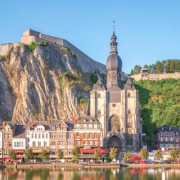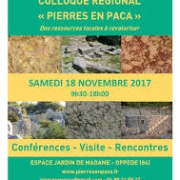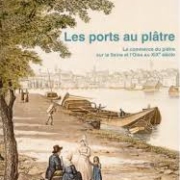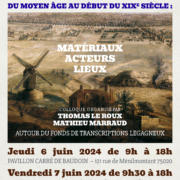FROM QUARRIES TO ROCK-CUT SITES – Echoes of stone crafting
Online conference, 25-26 March 2021
The archaeological study of quarries focuses mainly on the reconstruction of the extraction process, while rock-hewn spaces have often been approached from the point of view architectural styles or art-history. Nevertheless, a holistic structural approach to the study these spaces could allow a better understanding of the agency of those who carved the stone. Stone quarries and rock-cut sites have rarely been included in global studies of historical landscapes and few are the forums dedicated to the theoretical and methodological debate over the importance that these sites have for the understanding of past societies: the conference cycle organized by Marie-Elise Gardel at Saint-Martin-le-Vieil over the past 15 years; the research seminars ” de la carrière à la construction ” coordinated by the Laboratoire de Médiévistique occidentale de Paris (LAMOP – Université Paris-Panthéon Sorbonne); the recent sessions at the conference of the European Association of Archaeologists (2017-2019) and at the symposium of the Society of Italian Medieval Archaeologists (SAMI) which took place in Matera in 2018.
The study of these structures raises many methodological problems for researchers: the subterranean nature of some sites prevents the presence of natural light; the narrowness of the passages makes surveying difficult and the presence of waste piles and big blocks make the observation of quarry fronts extremely difficult. These sites have often been perceived as the result of synchronic processes. Because of that, site layouts have long been the only objects of study, neglecting the analysis of the carving phases and the determination of the relative chronologies. Furthermore, few researchers seem interested in the study of excavation and extraction processes, essential for defining the economy of the sites, identifying and qualifying the human agents who contributed to the creation of this evidences and understanding the
organization and function of the space within the sites themselves.
The conference aims at carrying on the international debate on the archaeological investigation of ROCKCUT SPACES and STONE QUARRIES, considered as aspects of the same mining phenomenon: places in which specific empirical and handcrafted knowledge related to stone working is expressed and conveyed. The conference envisages a diachronic approach and therefore all case studies are welcome, without chronological limits. The meeting will be organized considering two different research
perspectives and observation scales:
– the analysis of the individual rock walls, considering the study of tool traces as a proxy for understanding the carving phases;
– the analysis of the structure (site/quarry) as a whole, by contextualizing the results of the study of the single walls.
The conference will be held on March 25th and 26th, 2021. Official language is English. Due to the current situation and in order to allow everybody to participate, the conference will move online. The event will be hosted on a platform supplied by the University of Pisa and streamed on YouTube and Facebook. The meeting will promote a participated reflection on the methods for documenting spaces that are carved in stone. A moment of exchange at the end of the first day will be devoted to questions of vocabulary, often revealing of different theoretical approaches and traditions of study.
The participation of PhD students and young researchers is encouraged.
CONFERENCE PROGRAMME
THURSDAY 25 MARCH
09:00 Opening remarks
09:20 KEYNOTE LECTURE: MARIE-LAURE DERAT, The Historical and Archaeological Study of the Site of Lalibela and its Challenges
09:40 Discussion
09:55 LUC STEVENS, Qualifications of Craftsmen Who Dug Souterrains in France (10th-15th Centuries) – Preliminary Results
10:15 FRANCESCA SOGLIANI AND BRUNELLA GARGIULO, The Vertical Stratigraphy in Rock-cut Complexes: The Case of the Church of S. Giovanni in Monterrone in Matera
10:35 ANAÏS LAMESA, Being Left-handed and Ambidextrous in Rock-hewn Church Worksites Over Time: Methodological Reflections
10:55 Discussion
11:10 COFFEE BREAK
11:20 JEAN-PIERRE GÉLY AND MARC VIRÉ, The Technique of Extracting Building Stone by « Stone-walling and Back-filling » in Paris: An Innovation of the Late Middle Ages
11:40 FERNANDO LIGUE-ENGAMBA, Stonework on the Mvanda Site in Haut-Nyong (East Cameroon): Lithic Remains and Rock Transformation Techniques
12:00 MANON ROUTHIAU, First Reflections on the Structural Analysis of Rock-hewn Caves in Lalibela’s Landscape, Ethiopia (First Results of the Surveys)
12:20 Discussion
12:35 LUNCH BREAK
13:45 VÍCTOR MANUEL LÓPEZ-MENCHERO BENDICHO, ÁNGEL JAVIER CÁRDENAS MARTÍN-BUITRAGO, ÁNGEL MARCHANTE ORTEGA AND JORGE ONRUBIA PINTADO, The Millstone Quarry of Piédrola (Alcázar de San Juan, Spain)
14:05 KATARINA ŠPREM, What to Expect When You’re Documenting and Excavating a Roman Quarry – Monte Del Vescovo, Istria, Croatia
14:25 DANIEL MORLEGHEM, When Quarry Waste Explains Tool Marks
14:45 Discussion
15:00 SHARING IDEAS AND BUILDING BRIDGES, The IRAAR Network: An International Community for the Study of Quarries and Rock-Cut Sites
FRIDAY 26 MARCH
09:00 Opening remarks
09:20 KEYNOTE LECTURE: GUILLAUME ROBIN, How do Rock-cut Architectures Relate With their Environment? The Example of Prehistoric Rock-cut Tombs in Ossi, Sardinia (Italy)
09:40 Discussion
09:55 MARIE-ELISE PORQUEDDU, Know-how and Technical Environment: Rethinking Through Technical Study the Emergence of Rock-cut Tombs in the Neolithic Mediterranean
10:15 NURIA CASTAÑEDA, SUSANA CONSUEGRA, JAVIER BAENA, PEDRO DÍAZ-DEL-RÍO, Middle Paleolithic Flint Extraction at Casa Montero (Madrid, Spain)
10:35 DANIELA GALAZZO, A Study of Quartzite Quarries in Egypt
10:55 Discussion
11:10 COFFEE BREAK
11:20 THIERRY GRÉGOR, JÉRÔME ROHMER, A. ALSUHAIBANI, Stone Extraction in Northwest Arabia, from the Iron Age to the Early 20th Century. New Insights from Dadan (Saudi Arabia)
11:40 CLAUDIA SCIUTO, The Hand, the Mind, and the Stone: Technical Tendencies and the Development of Collective Know-how in Stone Extraction Procedures
12:00 GERMANO GERMANÒ, Underground and Open-pit Quarries in Polignano a Mare (Italy): a Preliminary Investigation
12:20 Discussion
12:35 LUNCH BREAK
13:45 PAUL PEIGNOT, The Alleged Pre-Nabataean Chambers at Hegra
14:05 CHRISTOPHER J. LYES, Theorising Ancient Quarries: How Far Have We Come?
14:25 GIANCARLO PASTURA, ELISABETTA DE MINICIS, MATTEO ZAGAROLA, LETIZIA TESSICINI, The Evolution of Negative Architectures: Two Cases from Orte (VT, Italy)
14:45 Discussion
15:00 KEYNOTE LECTURE: FRANCESCA SOGLIANI, The DARHEM Project – Digital Atlas of Rupestrian Heritage of Matera
15:20 Discussion









